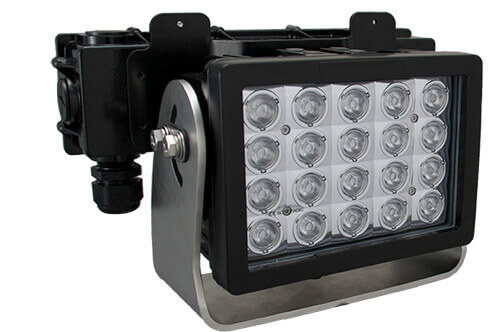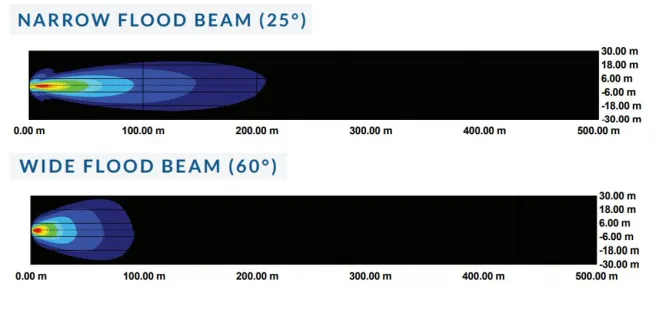Choosing the right deck light can often be a complex process, so Imtra’s Northeast Commercial Sales Manager, Nate Cabral, goes through the important factors to consider when picking a deck light.
What do you need the deck light for?
It may seem obvious, but spending some time thinking about exactly what area of the deck you’re trying to light up, and why it needs to be illuminated, will go a long way in determining what deck light will be best for your application. Will these lights be forward-facing headlights to aid the operator’s vision at night, or will they be used to illuminate an area on board to aid passengers and crew? Will the lights light up a walkway for passengers to see while boarding at night, or a large area of deck where the crew will be working?
A deck light to be used for a headlight or a narrow walkway light dictates using a light with a narrow and focused beam like a spotlight, while a floodlight would be needed to illuminate a large aft deck. So defining the exact intent of the deck light goes a long way in determining which one is the best choice for your vessel. Since LED lights have become more popular than halogens, it’s also important to know what to consider when choosing your marine LED lights.
Where will the deck lights be installed?
Just as important as determining what area needs to be illuminated, is determining the exact mounting location of your deck lights. Space is a precious commodity on any boat, so picking the spot where you will install the deck lights is an important step before purchasing any lights.
Where they get installed will determine the mounting-style of the light you’ll need. Will the light be installed on a flat horizontal surface, on a mast, or on a vertical bulkhead? Most deck lights have a specific style of mounting and won’t work in every application, so knowing how yours will need to be installed will help you narrow down your options.

In addition, many deck lights are adjustable and can be swiveled either up & down or to port & starboard. Knowing how and where the lights will mount on your boat will determine whether or not the adjustability of the light is important to you.
Knowing the installation location is also important for knowing how far the light will have to travel to illuminate the intended area. That distance is extremely important in determining the light intensity and beam angle that you will need.
Beam Angle
Once you’ve determined the mounting location and how far away it is from the area in which the light is needed, the next step is to select a light with the proper beam angle. Beam angle refers to the focus of the beam of light emitting from the fixture, ranging from a narrow, focused beam to a widespread floodlight. For example, the spotlight on top of a police car has a very narrow beam angle, intended to throw a focused beam of high-intensity light over long distances, while the headlight of a car has a much wider beam angle, intended to light up the surrounding area immediately in front of the car.
In the context of choosing the proper deck light, it simply becomes a question of geometry and determining which beam angle will result in the fixture throwing the most light where you need it. Two light fixtures with the exact same intensity can throw light in significantly different patterns depending on the beam angle. This is demonstrated in the graphic below, which shows the light pattern of Imtra’s Offshore 12-LED Deck Light in both a 25° beam-angle fixture, and a 60° beam-angle fixture. As you can see, just the 35° difference in beam angles results in a drastically different pattern of light, with one throwing visible light over 100 meters further in one direction.

So if you’re lighting up a small ramp or passageway for passengers to board the vessel safely, using a light that is high up above on a mast, selecting a fixture with a narrower beam angle will make sure that there is plenty of focused light on the intended area. Conversely, if you intend to light up a wide aft deck where the crew will be working and the light is mounted right on the back of the cabin or pilothouse, a wide beam angle, or floodlight, would be a better choice.
Light Intensity & Temperature
The intensity of the light is also important in that you don’t want it to be either too dim or too bright. If the light is too bright it may hurt the night-vision of the operator or crew and lead to impaired vision, and obviously, a light that isn’t bright enough won’t accomplish the task for which it is intended. Because it’s very rare to know exactly how many lumens are needed to accomplish your goal, it is best to consult a lighting expert in choosing the proper intensity for your application.
The color temperature of the light output is also important. Color temperature is measured in Kelvin and most deck lights are around 5500-6000K, also described as cool white. For the most part that is the best option for an exterior light, but some crews on vessels that operate in consistently foggy conditions prefer to use deck lights with more of an amber color, closer to 2400-2800K, as the amber light doesn’t reflect off of fog & mist as severely as a cool white light would.
Quality of Materials
By definition, deck lights are exterior lights that are exposed to the elements, so the quality of the construction of the fixture is crucial. Make sure the light you’re considering is a marine-grade product, built specifically for use aboard an ocean-going vessel. Be sure any mounting brackets are made of stainless steel or another material that is resistant to corrosion from both sun and water.
Ingress Protection (IP) ratings for lights measure the degree to which a fixture is protected from the intrusion of water or dust particles. Any light being used as a deck light should have a minimum rating of IP66, which means the fixture is protected against powerful water jets, but we typically recommend IP67 or higher, which includes temporary submersion, so that the fixture will hold up to crashing waves and driving rain.
Watch As Nate Cabral Discusses Our Wide Variety of Boat Deck Lights and Marine Utility Lights
3 Key Takeaways for Finding the Best Boat Deck Lights
1. Placement and orientation
Perhaps the biggest factor to consider when buying boat deck lights since space is a precious commodity and understanding how these LED lights will be used on your boat.
2. Color and intensity
LED boat deck lights come in a wide variety of colors which are measured in Kelvin units. A higher Kelvin unit will project more blue-white tones and a lower Kelvin unit will project warmer tones. Understanding the use cases of these LED lights (safety, navigation, or cosmetic) will help you determine which color you should buy for your boat.
3. Quality matters
It may go without saying, but you get what you pay for. Investing in high-quality marine-grade boat deck lights will save you money in the long run. Quality LED lights will have an IP rating to prevent condensation behind the lens and are also engineered to effectively disperse heat. Buying cheap LED lights will have to be replaced more often when that time could be better used enjoying the water.
Whether your deck lights are installed for the benefit of the crew or the passengers, they are a piece of safety equipment to ensure everyone on board can see adequately regardless of the conditions. Be sure to carefully consider all of these factors before outfitting your vessel with deck lights so that you can be sure you’ve selected the proper lights for your application.
If you’re in the market for purchasing deck lights for your boat or want to upgrade, check out Imtra's new offering of Lumishore curved spotlights & flood lights, or contact us today for more information.